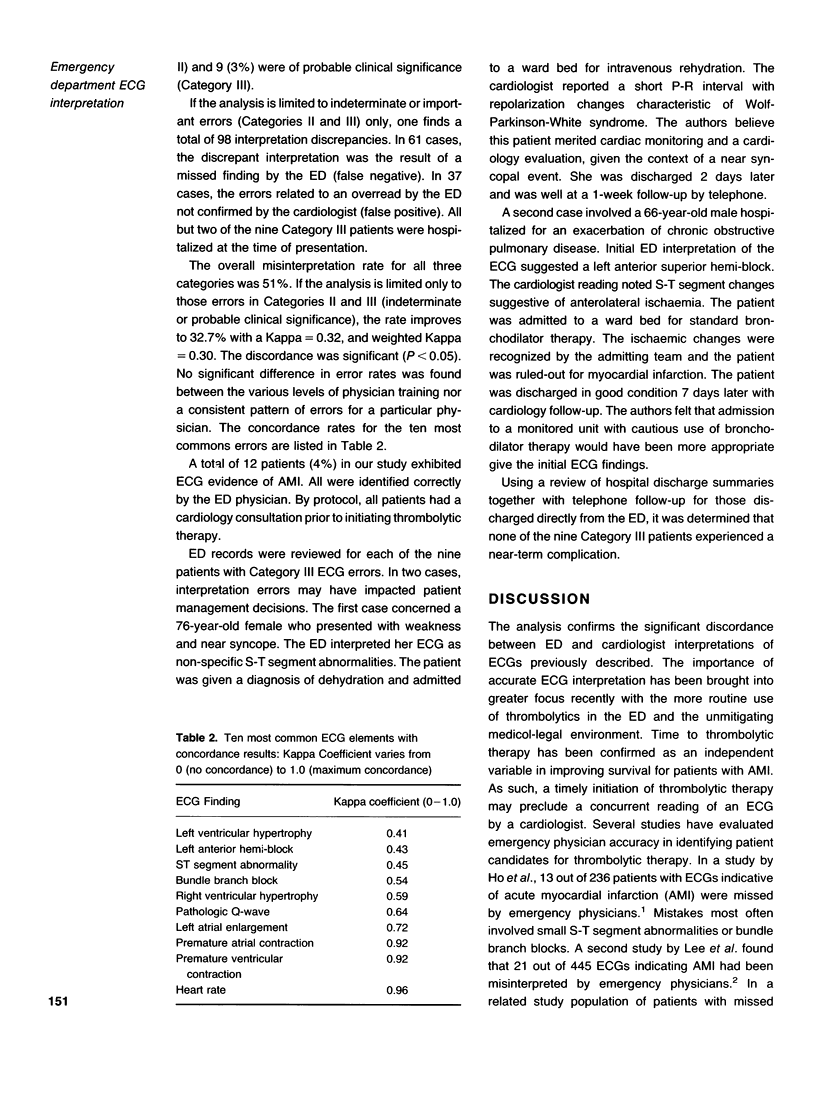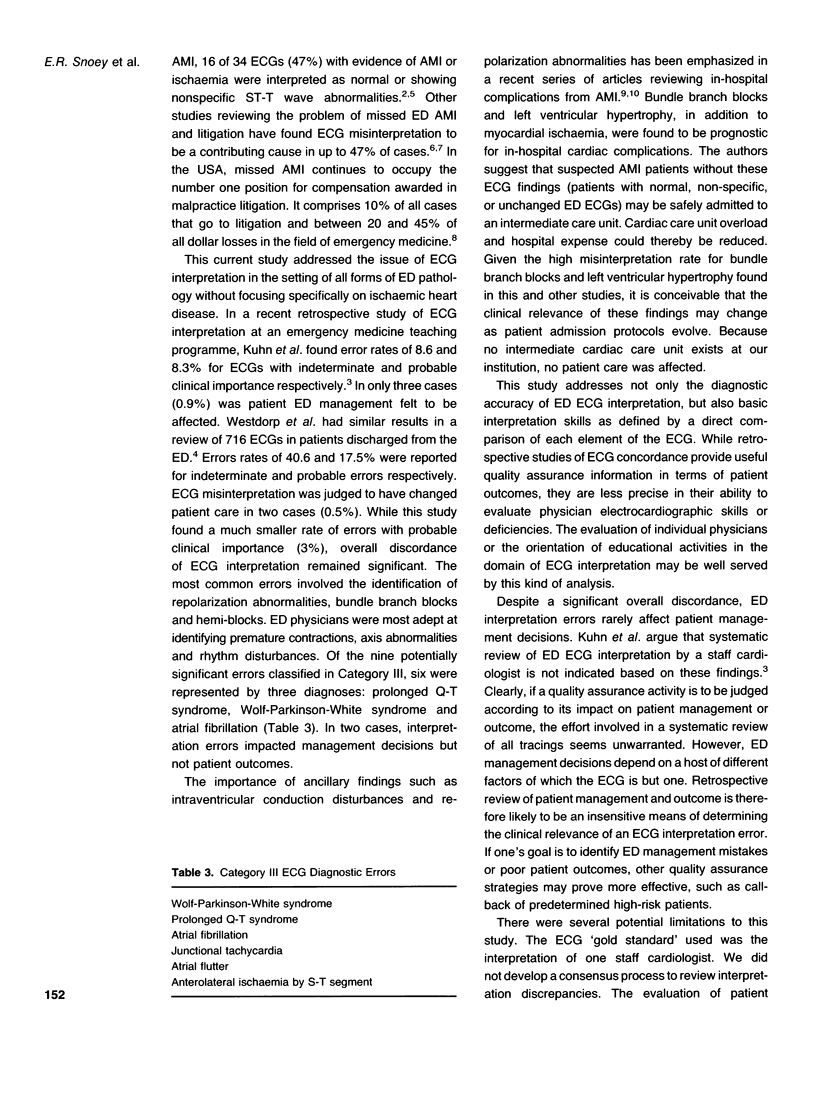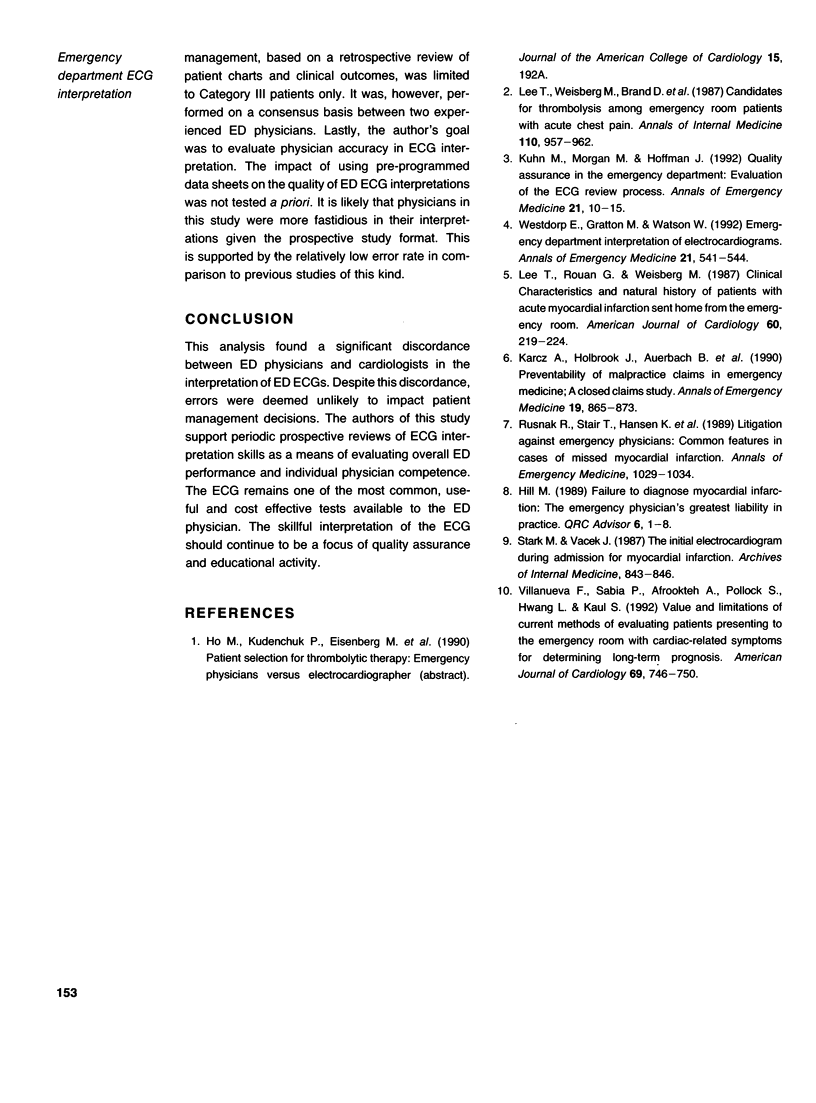Abstract
The objective of the study was to determine the concordance of emergency physicians' and cardiologists' interpretations of emergency department (ED) electrocardiograms (ECG), to evaluate the impact of ECG misinterpretation on patient management, and to determine error rates as a function of the level of physician training and the specific ECG diagnoses. ECG interpretations were registered prospectively using a programmed-response data sheet. A second blinded interpretation by a staff cardiologist was assumed to be correct. Only ECG discrepancies with potential or probable clinical importance were considered as errors. The ED management of patients with ECG misinterpretations was reviewed by the investigators. The study was performed at an urban university hospital using 300 consecutive ED ECGs. The analysis found 154 errors of interpretation of which nine had probable clinical significance, and 56 had indeterminant significance. The concordance was weak at 0.69 (Kappa = 0.32, weighted Kappa = 0.30) with a significant discordance (McNemar Chi 2:P < 0.05). Error rates did not differ significantly between the diverse categories of physicians. In two cases, interpretation errors impacted patient management decisions but not patient outcomes. The most frequent errors involved repolarization abnormalities, ventricular hypertrophy and hemi-blocks. While discordance was significant, errors in ECG interpretation rarely impacted patient management. Prospective evaluation of ECG interpretation may be a useful means of gauging physician skills. It can also serve to focus educational activities on problem areas in electrocardiography.
Full text
PDF




Selected References
These references are in PubMed. This may not be the complete list of references from this article.
- Hill M. Failure to diagnose myocardial infarction: the emergency physician's greatest liability in practice. QRC Advis. 1989 Dec;6(2):1–8. [PubMed] [Google Scholar]
- Karcz A., Holbrook J., Auerbach B. S., Blau M. L., Bulat P. I., Davidson A., 3rd, Docimo A. B., Doyle M. J., Erdos M. S., Friedman M. Preventability of malpractice claims in emergency medicine: a closed claims study. Ann Emerg Med. 1990 Aug;19(8):865–873. doi: 10.1016/s0196-0644(05)81559-8. [DOI] [PubMed] [Google Scholar]
- Kuhn M., Morgan M. T., Hoffman J. R. Quality assurance in the emergency department: evaluation of the ECG review process. Ann Emerg Med. 1992 Jan;21(1):10–15. doi: 10.1016/s0196-0644(05)82229-2. [DOI] [PubMed] [Google Scholar]
- Lee T. H., Rouan G. W., Weisberg M. C., Brand D. A., Acampora D., Stasiulewicz C., Walshon J., Terranova G., Gottlieb L., Goldstein-Wayne B. Clinical characteristics and natural history of patients with acute myocardial infarction sent home from the emergency room. Am J Cardiol. 1987 Aug 1;60(4):219–224. doi: 10.1016/0002-9149(87)90217-7. [DOI] [PubMed] [Google Scholar]
- Lee T. H., Weisberg M. C., Brand D. A., Rouan G. W., Goldman L. Candidates for thrombolysis among emergency room patients with acute chest pain. Potential true- and false-positive rates. Ann Intern Med. 1989 Jun 15;110(12):957–962. doi: 10.7326/0003-4819-110-12-957. [DOI] [PubMed] [Google Scholar]
- Rusnak R. A., Stair T. O., Hansen K., Fastow J. S. Litigation against the emergency physician: common features in cases of missed myocardial infarction. Ann Emerg Med. 1989 Oct;18(10):1029–1034. doi: 10.1016/s0196-0644(89)80924-2. [DOI] [PubMed] [Google Scholar]
- Stark M. E., Vacek J. L. The initial electrocardiogram during admission for myocardial infarction. Use as a predictor of clinical course and facility utilization. Arch Intern Med. 1987 May;147(5):843–846. [PubMed] [Google Scholar]
- Villanueva F. S., Sabia P. J., Afrookteh A., Pollock S. G., Hwang L. J., Kaul S. Value and limitations of current methods of evaluating patients presenting to the emergency room with cardiac-related symptoms for determining long-term prognosis. Am J Cardiol. 1992 Mar 15;69(8):746–750. doi: 10.1016/0002-9149(92)90499-o. [DOI] [PubMed] [Google Scholar]
- Westdrop E. J., Gratton M. C., Watson W. A. Emergency department interpretation of electrocardiograms. Ann Emerg Med. 1992 May;21(5):541–544. doi: 10.1016/s0196-0644(05)82521-1. [DOI] [PubMed] [Google Scholar]


